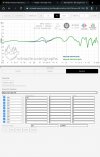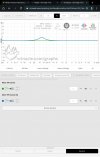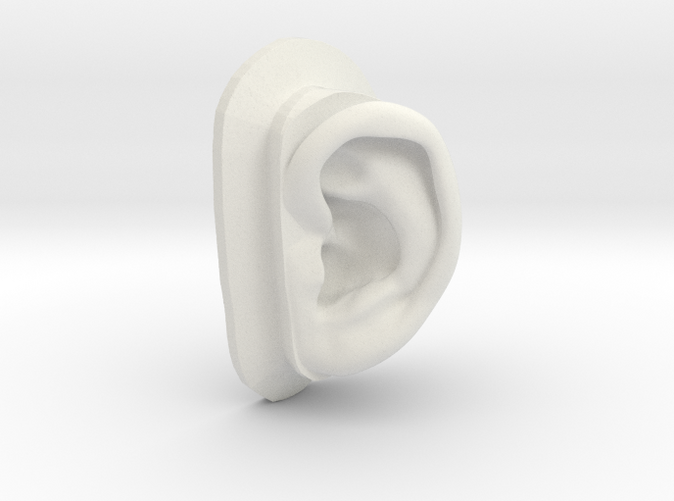-
WANTED: Happy members who like to discuss audio and other topics related to our interest. Desire to learn and share knowledge of science required. There are many reviews of audio hardware and expert members to help answer your questions. Click here to have your audio equipment measured for free!
- Forums
- Audio, Audio, Audio!
- Headphones and Headphone Amplifier Reviews
- Headphone & IEM Reviews & Discussions
You are using an out of date browser. It may not display this or other websites correctly.
You should upgrade or use an alternative browser.
You should upgrade or use an alternative browser.
What's the best measuring rig you can make at home?
- Thread starter edahl
- Start date
someguyontheinternet
Active Member
I know that the miniDSP EARS exists and if I remember correctly, some members have/had used it. I don't remember who exactly it was though, maybe someone has a better memory than me and can point you to the members.
miniDSP EARS
Some pointers in regards to the limitations of the MiniDSP EARS : https://www.soundstagesolo.com/inde...-death-of-headphone-measurement-or-its-savior
(I have no experience with it myself nor any of the industry standard rigs).
One of the least accessible things in headphones is the ability to do measurements.
Perhaps a good question to ask would be : what are you looking for ?
Ex :
- measuring sample variation between the same model of headphones
- measuring channel balance
- measuring the difference between two headphones
- measuring how your own headphones sound to you
- etc.
Last edited:
edahl
Senior Member
- Joined
- Jan 18, 2021
- Messages
- 398
- Likes
- 328
- Thread Starter
- #6
That's very useful!Some pointers in regards to the limitations of the MiniDSP EARS : https://www.soundstagesolo.com/inde...-death-of-headphone-measurement-or-its-savior
(I have no experience with it myself nor any of the industry standard rigs).
I'd like to check channel balance, I'd like to compare headphones, and I want to check the effects of EQ filters.Perhaps a good question to ask would be : what are you looking for ?
Ex :
- measuring sample variation between the same model of headphones
- measuring channel balance
- measuring the difference between two headphones
- measuring how your own headphones sound to you
- etc.
That's very useful!
I'd like to check channel balance,
Preferably not in-ear mics for that application then (your head is asymmetrical).
Is the EARS well manufactured and calibrated enough that channel matching can be properly assessed with it ?
Perhaps a simple flat plate could be used as well ?
Others may chime in as they'll have more experience than me in that regard.
I'd like to compare headphones,
That would be best left to industry standard equipment if you want the results you obtain to have the pretence to be applicable to others, and in-ear mics if you'e only interested in how your own samples work for you.
A possibly better alternative to the EARS would be a Chinese knock-off of the 711 coupler as it seems to be a better approximation of the human ear. Earfonia among others will know more on this subject :

Earfonia IEM Measurement Setup & Methodology
One of the main objectives of In-Ear Monitor measurement (as well as other audio equipment measurements) is to understand the correlation of the perceived sound quality with the numbers and graphs. I’ve been doing IEM measurement for a while now, just as a hobby, to learn how to correlate what I...
 www.audiosciencereview.com
www.audiosciencereview.com
In-ear mics may not provide truly accurate results in terms of the relative difference between headphones without some investigation on your end on what works best for you, and all the different techniques that I've experimented with have pluses and minuses in that regard. What I find most useful in the end is to use different mics and compare their results, instead of focusing on one hypothetically ideal approach. This is not an easy rabbit hole to get into (you can't just purchase any "binaural mics" you find on the web, plonk them on your head, and be confident that the results you'll get will be valid).
and I want to check the effects of EQ filters.
Are you worried that the EQ filters you apply aren't perfectly reproduced by your headphones ? In my limited experience it is possible, but rather rare.
Several approaches may be valid as a way to test for this.
I have a MiniDSP EARS. Obviously, it's not perfect (but nor is a GRAS) however with a bit of tweaking of calibration curves I can get close enough to results published by Amir, Oratory etc. to 'trust' what the EARS is showing. I use it mostly to make my own PEQ filters for the headphones I own for use in Moode/CamillaDSP. The advantage of the EARS over just using publicly available measurements is that I can account for my own hearing peculiarities as well as unit variation of the headphones and then directly compare what I (think I) hear with what I see on the chart in REW.I know that the miniDSP EARS exists and if I remember correctly, some members have/had used it.
edahl
Senior Member
- Joined
- Jan 18, 2021
- Messages
- 398
- Likes
- 328
- Thread Starter
- #9
Seems likely there's a use for both in my casePreferably not in-ear mics for that application then (your head is asymmetrical).
It's for personal use, but I should perhaps look into these 711 knock-offsThat would be best left to industry standard equipment if you want the results you obtain to have the pretence to be applicable to others, and in-ear mics if you'e only interested in how your own samples work for you.
A possibly better alternative to the EARS would be a Chinese knock-off of the 711 coupler as it seems to be a better approximation of the human ear. Earfonia among others will know more on this subject :
I rarely see people measure headphones after EQ, so I just want to see it done. The reason is just that there's something I don't quite understand:Are you worried that the EQ filters you apply aren't perfectly reproduced by your headphones ? In my limited experience it is possible, but rather rare.
Several approaches may be valid as a way to test for this.
If an FR graph is read as a relative dB output pr. unit of volt and EQ means a local voltage boost (or reduction) that is essentially the same everywhere it's applied, I would not expect the output to be simply additive in the output, but FR-linear, i.e. it would boost the output by a parameter that is proportional to the relative FR at the given frequency. There's probably something missing from the way I'm attempting to understand it though lol
staticV3
Master Contributor
- Joined
- Aug 29, 2019
- Messages
- 8,004
- Likes
- 12,837
I think there's a misunderstanding here. If you measure the frequency response of a headphone, apply a set EQ to it, then graph the difference between pre EQ and post EQ, then the result will be exactly the EQ you entered. There's no dependency on the headphone's stock frequency response there. You can repeat that with different headphones and the result will stay the same.
E.g.: same EQ applied to different headphones


But if you plot the difference pre EQ <-> post EQ, they're the same:


That's because headphones are deterministic in nature. The signal amplitude you put in is directly correlated to the sound pressure level you get out.
E.g.: same EQ applied to different headphones


But if you plot the difference pre EQ <-> post EQ, they're the same:


That's because headphones are deterministic in nature. The signal amplitude you put in is directly correlated to the sound pressure level you get out.
edahl
Senior Member
- Joined
- Jan 18, 2021
- Messages
- 398
- Likes
- 328
- Thread Starter
- #11
There's something I don't understand about why that works the way it does, but I appreciate it!I think there's a misunderstanding here. If you measure the frequency response of a headphone, apply a set EQ to it, then graph the difference between pre EQ and post EQ, then the result will be exactly the EQ you entered. There's no dependency on the headphone's stock frequency response there. You can repeat that with different headphones and the result will stay the same.
E.g.: same EQ applied to different headphones
View attachment 203306View attachment 203307
But if you plot the difference pre EQ <-> post EQ, they're the same:
View attachment 203308View attachment 203309
That's because headphones are deterministic in nature. The signal amplitude you put in is directly correlated to the sound pressure level you get out.
D
Deleted member 16543
Guest
When I made these my intention was for people to use them for DIY binaural recordings.

 www.shapeways.com
www.shapeways.com
The material is not great to measure headphones that touch the pinna. It's too hard.
But with some molding and casting skills one could make a cheap home made B&K 5128 with them.
It would be interesting to compare measurements done with such a DIY mic with those from Soundguys. I think they're the only ones to use a B&K 5128, at least for now.

DIY binaural microphone ears by sax512 - Shapeways Shops
B&K 5128 alternative ear replicas with anatomically accurate ear canals for DIY binaural microphone and headphones measurement
The material is not great to measure headphones that touch the pinna. It's too hard.
But with some molding and casting skills one could make a cheap home made B&K 5128 with them.
It would be interesting to compare measurements done with such a DIY mic with those from Soundguys. I think they're the only ones to use a B&K 5128, at least for now.
That's because headphones are deterministic in nature. The signal amplitude you put in is directly correlated to the sound pressure level you get out.
There's something I don't understand about why that works the way it does, but I appreciate it!
I think another name for this is minimum phase. And I don't really understand it either.
I agree with edahl, btw, that it'd be nice if reviewers could show how their EQ settings actually alter the headphone's measured frequency response, as opposed to just computing the difference in software. This may be one of the limitations of their measurement systems though.
D
Deleted member 16543
Guest
Minimum phase means that phase response can be calculated from amplitude response.
I think the general assumption is that, at least on first approximation, headphones are minimum phase response systems. That's probably true when one considers headphones as isolated systems, without examining their interaction with the human head once you put them on.
So when one EQs amplitude, the phase gets automatically corrected too.
Two for one.
I think that what staticV3 is talking about is actually a linear time invariant system (LTI). Which means that when you multiply the input by a constant, the output is also multiplied by the same constant, and when you use an input that is the sum of 2 or more inputs, the output is also the sum of each individual outputs.
On first approximation that might be true for headphones, but when you consider cancellations in the measured response (dips), that doesn't apply as much anymore.
You may use EQ and add 20 dB at a specific frequency where you have a 20 dB dip, and end up with no change at all on the measured response.
That's because dips due to cancellations can't be EQed. The net result will always be a cancellation.
Those kinds of dips are caused by the interaction between the headphones and the rig, and that's why a realistic replica of the pinna and ear canal is important, when simulating the pressure sensed at the eardrum by a listener.
If you change the geometric boundaries by using a less anatomically accurate rig you also change the cancellations.
That's not the only thing that changes, but cancellations are a good enough and somewhat easy example to explain the value of anatomic accuracy in headphones measurement rigs.
That's why I also agree that a measured response after EQ is much more valuable than simply correcting the raw response and showing the calculated FR after EQ.
And why I think that Soundguys have the most useful measurements around, by virtue of using the most anatomically accurate rig available.
The problem is, they don't have that many measurements, and their target curve is in my opinion too arbitrarily derived.
However, their B&K 5128 is definitely the most accurate (least inaccurate?) rig when it comes to show differences between headphones.
Different rigs (less anatomically accurate ones) produce plot differences among different headphones that are not as indicative of the actual pressure difference sensed at the eardrum of the listener.
I think the general assumption is that, at least on first approximation, headphones are minimum phase response systems. That's probably true when one considers headphones as isolated systems, without examining their interaction with the human head once you put them on.
So when one EQs amplitude, the phase gets automatically corrected too.
Two for one.
I think that what staticV3 is talking about is actually a linear time invariant system (LTI). Which means that when you multiply the input by a constant, the output is also multiplied by the same constant, and when you use an input that is the sum of 2 or more inputs, the output is also the sum of each individual outputs.
On first approximation that might be true for headphones, but when you consider cancellations in the measured response (dips), that doesn't apply as much anymore.
You may use EQ and add 20 dB at a specific frequency where you have a 20 dB dip, and end up with no change at all on the measured response.
That's because dips due to cancellations can't be EQed. The net result will always be a cancellation.
Those kinds of dips are caused by the interaction between the headphones and the rig, and that's why a realistic replica of the pinna and ear canal is important, when simulating the pressure sensed at the eardrum by a listener.
If you change the geometric boundaries by using a less anatomically accurate rig you also change the cancellations.
That's not the only thing that changes, but cancellations are a good enough and somewhat easy example to explain the value of anatomic accuracy in headphones measurement rigs.
That's why I also agree that a measured response after EQ is much more valuable than simply correcting the raw response and showing the calculated FR after EQ.
And why I think that Soundguys have the most useful measurements around, by virtue of using the most anatomically accurate rig available.
The problem is, they don't have that many measurements, and their target curve is in my opinion too arbitrarily derived.
However, their B&K 5128 is definitely the most accurate (least inaccurate?) rig when it comes to show differences between headphones.
Different rigs (less anatomically accurate ones) produce plot differences among different headphones that are not as indicative of the actual pressure difference sensed at the eardrum of the listener.
Minimum phase means that phase response can be calculated from amplitude response.
I think the general assumption is that, at least on first approximation, headphones are minimum phase response systems. That's probably true when one considers headphones as isolated systems, without examining their interaction with the human head once you put them on.
So when one EQs amplitude, the phase gets automatically corrected too.
Two for one.
Does this apply to both hardware and software EQs? I seem to recall reading somewhere (maybe on Gearspace?) that the phase was only properly corrected on hardware based EQs.
I think that what staticV3 is talking about is actually a linear time invariant system (LTI). Which means that when you multiply the input by a constant, the output is also multiplied by the same constant, and when you use an input that is the sum of 2 or more inputs, the output is also the sum of each individual outputs.
On first approximation that might be true for headphones, but when you consider cancellations in the measured response (dips), that doesn't apply as much anymore.
You may use EQ and add 20 dB at a specific frequency where you have a 20 dB dip, and end up with no change at all on the measured response.
That's because dips due to cancellations can't be EQed. The net result will always be a cancellation.
Those kinds of dips are caused by the interaction between the headphones and the rig, and that's why a realistic replica of the pinna and ear canal is important, when simulating the pressure sensed at the eardrum by a listener.
If you change the geometric boundaries by using a less anatomically accurate rig you also change the cancellations.
That's not the only thing that changes, but cancellations are a good enough and somewhat easy example to explain the value of anatomic accuracy in headphones measurement rigs.
Yes.
I think I've mentioned this previously, but I've tried a number of different methods of EQ, using both hardware and software-based solutions, including graphic EQs, like the DBX 215s and 231s. And it seems to me that you don't always get out exactly what you put in. Especially if a headphone has a limited ability to extend into the lower frequencies, like many open dynamics for example. But I like your example about cancellation as well.
That's why I also agree that a measured response after EQ is much more valuable than simply correcting the raw response and showing the calculated FR after EQ.
And why I think that Soundguys have the most useful measurements around, by virtue of using the most anatomically accurate rig available.
The problem is, they don't have that many measurements, and their target curve is in my opinion too arbitrarily derived.
However, their B&K 5128 is definitely the most accurate (least inaccurate?) rig when it comes to show differences between headphones.
Different rigs (less anatomically accurate ones) produce plot differences among different headphones that are not as indicative of the actual pressure difference sensed at the eardrum of the listener.
I am paying close attention to the Sound Guys 5128 measurements as well. And also Jude's new 5128 measurements. And I'd like to see some in-ear measurements of speakers done on this rig. The Sound Guys targets need work though, as you say. So I use my own (which, as you probably know, is based on the HBK 5128 diffuse field response curve, and sound power response of neutral loudspeakers).
The recent Sound Guys 5128 plot of the Senn HD 6XX doesn't look too bad for an open dynamic headphone. Though it might be a little too bright or uneven in some spots in the upper mids and treble...
The new Senn Momentum 4 also doesn't have too bad a shape, except for maybe a little excess energy in the sub-bass, and perhaps a bit too much emphasis mid-treble?...
I'm still looking at (and trying to better assess) alot of these plots though.
Examples of a couple of my target estimation curves for comparison to the above...
These are only coarse approximations btw. And some additional bumpiness/unevenness is expected and perfectly normal in the treble, on the actual headphone plots.
Last edited:
D
Deleted member 16543
Guest
Does this apply to both hardware and software EQs? I seem to recall reading somewhere (maybe on Gearspace?) that the phase was only properly corrected on hardware based EQs.
Hardware EQ is minimum phase since it uses minimum phase components (R-L-C).
Software can be both minimum phase (IIR) or "phase configurable" (FIR).
...
I am paying close attention to the Sound Guys 5128 measurements as well. And also Jude's new 5128 measurements. And I'd like to see some in-ear measurements of speakers done on this rig. The Sound Guys targets need work though, as you say. So I use my own (which, as you probably know, is based on the HBK 5128 diffuse field response curve, and sound power response of neutral loudspeakers).
The recent Sound Guys 5128 plot of the Senn HD 6XX doesn't look too bad for an open dynamic headphone. Though it might be a little too forward or uneven in some spots in the upper mids and treble...
The new Senn Momentum 4 also doesn't have too bad a shape, except for a little excess energy in the sub-bass, and perhaps a bit too much emphasis mid-treble?...
I'm still looking at (and trying to better assess) alot of these plots though.And perhaps those qualities might be desirable for some lower volume listening.
Man, that's a nice plot for the 6XX!
To be honest, I'm not much of a headphone guy. But I recently needed to get a pair of over-ears and I ended up with the 58X Jubilee (after returning a lot of other headphones).
They sound quite natural to me, considering price and the non-critical use I make of them.
D
Deleted member 16543
Guest
Also, I was completely unaware of Jude's existence until today (this should tell you how much I prefer speakers over headphones  ), but from a quick search I found this great video:
), but from a quick search I found this great video:
He really seems to get it. Which is comforting, since I've been beating this dead horse since at least 2017 (https://gearspace.com/board/all-things-technical/1152136-better-binaural-microphone.html), with a much needed (in nerd's terms, so to speak, so not really needed at all) more technical follow up explanation a couple years after (https://gearspace.com/board/all-things-technical/1288581-binaural-theory.html).
I just find it ironic that a guy like me, who has not that much interest in headphones, can "inadvertently" end up making something that, at least in my opinion, is still after these many years the closest DIY approximation to the best headphone measuring rig out there (B&K 5128). A rig that came out years after I made my DIY ears for binaural microphones.
If it turns out that there's enough interest I may try to find a way to offer those ears in a rubber or silicone like material. Unfortunately Shapeways doesn't offer that.
He really seems to get it. Which is comforting, since I've been beating this dead horse since at least 2017 (https://gearspace.com/board/all-things-technical/1152136-better-binaural-microphone.html), with a much needed (in nerd's terms, so to speak, so not really needed at all) more technical follow up explanation a couple years after (https://gearspace.com/board/all-things-technical/1288581-binaural-theory.html).
I just find it ironic that a guy like me, who has not that much interest in headphones, can "inadvertently" end up making something that, at least in my opinion, is still after these many years the closest DIY approximation to the best headphone measuring rig out there (B&K 5128). A rig that came out years after I made my DIY ears for binaural microphones.
If it turns out that there's enough interest I may try to find a way to offer those ears in a rubber or silicone like material. Unfortunately Shapeways doesn't offer that.
Maybe not the answer to your question, but sonarworks will characterize a headset for you.
Similar threads
- Replies
- 4
- Views
- 693
- Replies
- 13
- Views
- 2K
- Replies
- 5
- Views
- 645
- Replies
- 2
- Views
- 465
- Replies
- 773
- Views
- 80K
